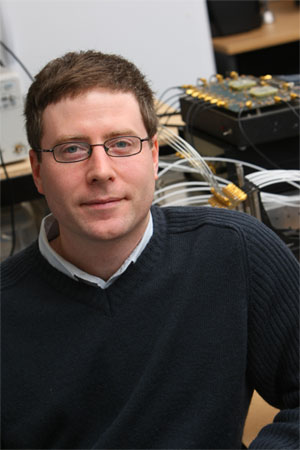 |
| Jeremy Brown is an assistant professor with the Faculty of Engineering's School of Biomedical Engineering. (Nick Pearce Photo) |
Imagine an ultrasound device so small, it could travel through the eardrum, onwards through the middle ear and then rest against the inner ear to provide images of the basilier membrane as at it vibrates, sending messages to the brain as it interprets sound.
Itās not science fiction a la Fantastic Voyageāitās what pilipiliĀž» researcher Jeremy Brown is developing in collaboration with ear surgeon Manohar Bance.
Ģż
āWeāve been taking whatās called a ābench top to bedsideā approach,ā says Dr. Brown, assistant professor of Biomedical Engineering at pilipiliĀž». āIād have no idea if this was possible unless I was paired with a surgeon ā¦ the collaboration is working out great so far.ā
The miniature device, a medical imaging technique that uses high frequency sound waves and their echoes, measures a mere two millimeters in diameter. Yet, even at the size of a tiny bead, the probe contains 150 elementsātiny transducers that vibrate when electric signals are applied. Once planted deep within the ear through a minor surgical procedure, the probe would be able to detect scarring from implants in the middle ear, for example, or detect the ravages of diseases like Meniereās, an inner-ear disorder which causes episodes of vertigo.
āTo me, this is revolutionary,ā says Dr. Bance, professor of Otology, Neurotology and Skull Base Surgery with Dalhousieās Faculty of Medicine. āRight now, we donāt have any way to see inside the inner ear, and this will allow us to diagnose inner-ear problems. Itās like exploring a whole new world.ā
Now, the researchers are ready to take the next step and build on prototypes that have been tested on mice. Money received from the Canadian Foundation for Innovationās Leaders Opportunity Fund and matched by the Nova Scotia Research and Innovation Trustā$311,000 all toldāwill allow them to acquire equipment developed by the semi-conductor industry to build and further refine the miniature devices.
āThis equipment is so unbelievably good, that we can just piggyback on it to do what we need it to do,ā says Dr. Brown.
He is also collaborating with Dr. Bance on a second āsmallā project, to develop tiny, surgically implanted hearing aids.
āGood things happen when you bring scientists to the front lines where the patients are,ā says Dr. Bance. āOtherwise you have people working in isolation without actually knowing if thereās a need or if what they come up with will work in practice.ā
Besides Dr. Brownās project, āFabrication of Ultrasonic Micro-Arrays for Imaging the Ear and Auditory System,ā the Canadian Foundation for Innovation announced that four other projects at pilipiliĀž» have received funding through its Leaders Opportunity Fund and Nova Scotia Research and Innovation Trust:
- $312,188 for Dalhousie Auditory Electrophysiology Laboratory led by Steven Aiken, assistant professor with the School of Human Communications Disorders.
- $279,884 for the Laboratory of Applied Multiphase Thermal Engineering, led by Dominic Groulx, assistant professor in the Department of Mechanical Engineering.
- $416,351 for microcirculatory sepsis research led by professor Christian Lehmann, Department of Anesthesia. Sepsis is a systemic disease of the microcirculation.
- $303,154Ģż to study birdsong, a research initiative led by Leslie Phillmore, assistant professor of psychology.
